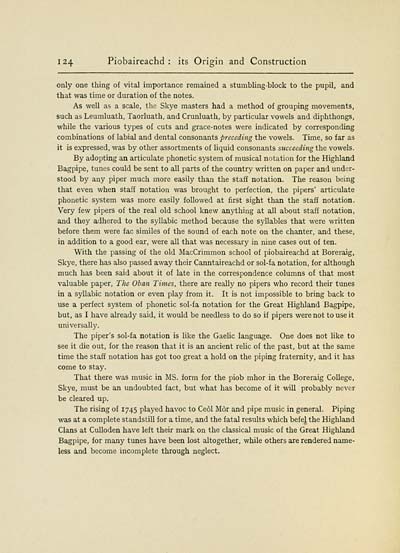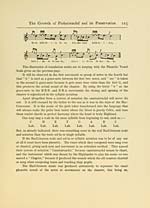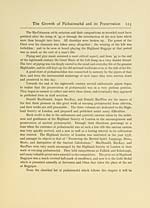Hew Morrison Collection > Piobaireachd
(130)
Download files
Complete book:
Individual page:
Thumbnail gallery: Grid view | List view

124 Piobaireachd : its Origin and Construction
only one thing of vital importance remained a stumbling-block to the pupil, and
that was time or duration of the notes.
As well as a scale, the Skye masters had a method of grouping movements,
such as Leumluath, Taorluath, and Crunluath, by particular vowels and diphthongs,
while the various types of cuts and grace-notes were indicated by corresponding
combinations of labial and dental consonants preceding the vowels. Time, so far as
it is expressed, was by other assortments of liquid consonants succeeding the vowels.
By adopting an articulate phonetic system of musical notation for the Highland
Bagpipe, tunes could be sent to all parts of the country written on paper and under-
stood by any piper much more easily than the staff notation. The reason being
that even when staff notation was brought to perfection, the pipers' articulate
phonetic system was more easily followed at first sight than the staff notation.
Very few pipers of the real old school knew anything at all about staff notation,
and they adhered to the syllabic method because the syllables that were written
before them were fac similes of the sound of each note on the chanter, and these,
in addition to a good ear, were all that was necessary in nine cases out of ten.
With the passing of the old MacCrimmon school of piobaireachd at Boreraig,
Skye, there has also passed away their Canntaireachd or sol-fa notation, for although
much has been said about it of late in the correspondence columns of that most
valuable paper. The Oban Times, there are really no pipers who record their tunes
in a syllabic notation or even play from it. It is not impossible to bring back to
use a perfect system of phonetic sol-fa notation for the Great Highland Bagpipe,
but, as I have already said, it would be needless to do so if pipers were not to use it
universally.
The piper's sol-fa notation is like the Gaelic language. One does not like to
see it die out, for the reason that it is an ancient relic of the past, but at the same
time the staff notation has got too great a hold on the piping fraternity, and it has
come to stay.
That there was music in MS. form for the piob mhor in the Boreraig College,
Skye, must be an undoubted fact, but what has become of it will probably never
be cleared up.
The rising of 1745 played havoc to Ceol M6r and pipe music in general. Piping
was at a complete standstill for a time, and the fatal results which befel the Highland
Clans at Culloden have left their mark on the classical music of the Great Highland
Bagpipe, for many tunes have been lost altogether, while others are rendered name-
less and become incomplete through neglect.
only one thing of vital importance remained a stumbling-block to the pupil, and
that was time or duration of the notes.
As well as a scale, the Skye masters had a method of grouping movements,
such as Leumluath, Taorluath, and Crunluath, by particular vowels and diphthongs,
while the various types of cuts and grace-notes were indicated by corresponding
combinations of labial and dental consonants preceding the vowels. Time, so far as
it is expressed, was by other assortments of liquid consonants succeeding the vowels.
By adopting an articulate phonetic system of musical notation for the Highland
Bagpipe, tunes could be sent to all parts of the country written on paper and under-
stood by any piper much more easily than the staff notation. The reason being
that even when staff notation was brought to perfection, the pipers' articulate
phonetic system was more easily followed at first sight than the staff notation.
Very few pipers of the real old school knew anything at all about staff notation,
and they adhered to the syllabic method because the syllables that were written
before them were fac similes of the sound of each note on the chanter, and these,
in addition to a good ear, were all that was necessary in nine cases out of ten.
With the passing of the old MacCrimmon school of piobaireachd at Boreraig,
Skye, there has also passed away their Canntaireachd or sol-fa notation, for although
much has been said about it of late in the correspondence columns of that most
valuable paper. The Oban Times, there are really no pipers who record their tunes
in a syllabic notation or even play from it. It is not impossible to bring back to
use a perfect system of phonetic sol-fa notation for the Great Highland Bagpipe,
but, as I have already said, it would be needless to do so if pipers were not to use it
universally.
The piper's sol-fa notation is like the Gaelic language. One does not like to
see it die out, for the reason that it is an ancient relic of the past, but at the same
time the staff notation has got too great a hold on the piping fraternity, and it has
come to stay.
That there was music in MS. form for the piob mhor in the Boreraig College,
Skye, must be an undoubted fact, but what has become of it will probably never
be cleared up.
The rising of 1745 played havoc to Ceol M6r and pipe music in general. Piping
was at a complete standstill for a time, and the fatal results which befel the Highland
Clans at Culloden have left their mark on the classical music of the Great Highland
Bagpipe, for many tunes have been lost altogether, while others are rendered name-
less and become incomplete through neglect.
Set display mode to: Large image | Transcription
Images and transcriptions on this page, including medium image downloads, may be used under the Creative Commons Attribution 4.0 International Licence unless otherwise stated. ![]()
| Early Gaelic Book Collections > Hew Morrison Collection > Piobaireachd > (130) |
|---|
| Permanent URL | https://digital.nls.uk/81165477 |
|---|
| Description | A selection of items from a collection of 320 volumes and 30 pamphlets of literary and religious works in Scottish Gaelic. From the personal library of Hew Morrison, the first City Librarian of Edinburgh. |
|---|
| Description | Selected items from five 'Special and Named Printed Collections'. Includes books in Gaelic and other Celtic languages, works about the Gaels, their languages, literature, culture and history. |
|---|

